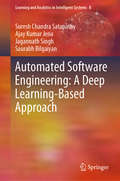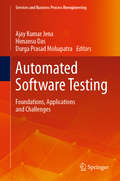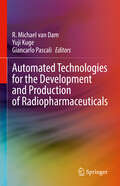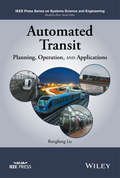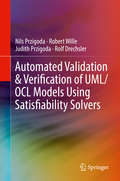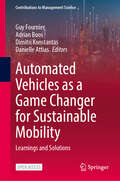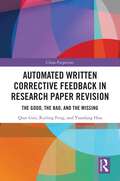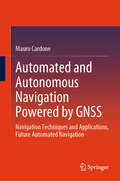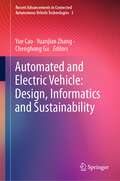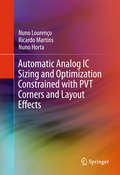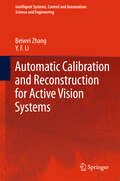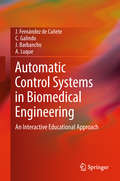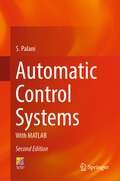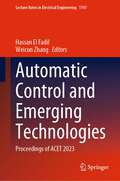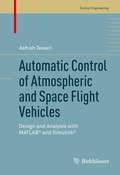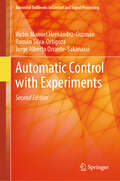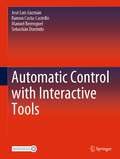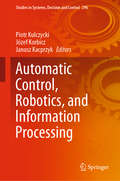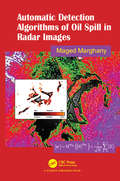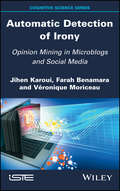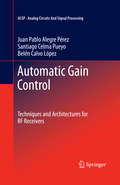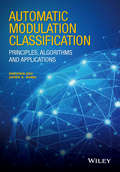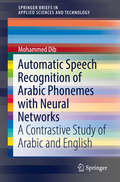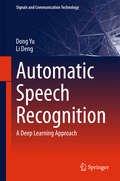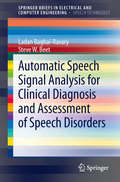- Table View
- List View
Automated Software Engineering: A Deep Learning-Based Approach (Learning and Analytics in Intelligent Systems #8)
by Suresh Chandra Satapathy Ajay Kumar Jena Jagannath Singh Saurabh BilgaiyanThis book discusses various open issues in software engineering, such as the efficiency of automated testing techniques, predictions for cost estimation, data processing, and automatic code generation. Many traditional techniques are available for addressing these problems. But, with the rapid changes in software development, they often prove to be outdated or incapable of handling the software’s complexity. Hence, many previously used methods are proving insufficient to solve the problems now arising in software development. The book highlights a number of unique problems and effective solutions that reflect the state-of-the-art in software engineering. Deep learning is the latest computing technique, and is now gaining popularity in various fields of software engineering. This book explores new trends and experiments that have yielded promising solutions to current challenges in software engineering. As such, it offers a valuable reference guide for a broad audience including systems analysts, software engineers, researchers, graduate students and professors engaged in teaching software engineering.
Automated Software Testing: Foundations, Applications and Challenges (Services and Business Process Reengineering)
by Durga Prasad Mohapatra Himansu Das Ajay Kumar JenaThis book covers both theory and applications in the automation of software testing tools and techniques for various types of software (e.g. object-oriented, aspect-oriented, and web-based software). When software fails, it is most often due to lack of proper and thorough testing, an aspect that is even more acute for object-oriented, aspect-oriented, and web-based software. Further, since it is more difficult to test distributed and service-oriented architecture-based applications, there is a pressing need to discuss the latest developments in automated software testing. This book discusses the most relevant issues, models, tools, challenges, and applications in automated software testing. Further, it brings together academic researchers, scientists, and engineers from a wide range of industrial application areas, who present their latest findings and identify future challenges in this fledging research area.
Automated Technologies for the Development and Production of Radiopharmaceuticals
by Yuji Kuge R. Michael van Dam Giancarlo PascaliThis is the first comprehensive book about the advanced technologies used in the radiopharmaceutical field. It covers each major area of radiopharmaceutical preparation, including radioisotope production and separation, multi-step radiosynthesis, analysis and quality control of the products as well as technologies for novel radiopharmaceutical development. Chapters are written by leaders in the field and comprehensively describe the evolution of relevant technologies, the current state-of-the-art, and future directions. The book will be an invaluable tool for researchers in radiochemistry or radiopharmaceutical development, disease researchers, and pharmaceutical researchers developing new drugs using in vivo imaging techniques in the drug development process.
Automated Transit: Planning, Operation, and Applications
by Rongfang LiuA comprehensive discussion of automated transit This book analyzes the successful implementations of automated transit in various international locations, such as Paris, Toronto, London, and Kuala Lumpur, and investigates the apparent lack of automated transit applications in the urban environment in the United States. The book begins with a brief definition of automated transit and its historical development. After a thorough description of the technical specifications, the author highlights a few applications from each sub-group of the automated transit spectrum. International case studies display various technologies and their applications, and identify vital factors that affect each system and performance evaluations of existing applications. The book then discusses the planning and operation of automated transit applications at both macro and micro levels. Finally, the book covers a number of less successful concepts, as well as the lessons learned, allowing readers to gain a comprehensive understanding of the topic. Key features: Provides a thorough examination of automated transit applications, their impact and implications for society Written by the committee chair for the Automated Transit Systems Transportation, Research Board Offers essential information on planning, costs, and applications of automated transit systems Covers driverless metros, automated LRT, group and personal rapid transit, a review of worldwide applications Includes capacity and safety guidelines, as well as vehicles, propulsion, and communication and control systems This book is essential reading for engineers, researchers, scientists, college or graduate students who work in transportation planning, engineering, operation and management fields. Dr. Rongfang Liu is a transportation professor in the Department of Civil and Environmental Engineering, New Jersey Institute of Technology (NJIT). Dr. Liu's research interests include Intermodal and Multimodal Transportation Planning and Engineering, Operation Research and Network Simulations, and transportation safety performance analyses. Dr. Liu is actively participating in various professional organizations and service activities. Since 2008, she has been the Chair of AP040 Committee: Automated Transit Systems, Transportation Research Board, and National Academy of Science. She was also the President of NACOTA (2006-2008), a federally registered non-profit organization for Chinese Overseas Transportation Professionals. Dr. Liu has authored and edited eight books, published more than 30 referred journal papers and book chapters, and made more than a hundred presentations in the transportation field. She is a registered professional engineer (PE) as well as a certified planner (AICP).
Automated Validation & Verification of UML/OCL Models Using Satisfiability Solvers
by Robert Wille Rolf Drechsler Nils Przigoda Judith PrzigodaThis book provides a comprehensive discussion of UML/OCL methods and design flow, for automatic validation and verification of hardware and software systems. While the presented flow focuses on using satisfiability solvers, the authors also describe how these methods can be used for any other automatic reasoning engine. Additionally, the design flow described is applied to a broad variety of validation and verification tasks. The authors also cover briefly how non-functional properties such as timing constraints can be handled with the described flow.
Automated Vehicles as a Game Changer for Sustainable Mobility: Learnings and Solutions (Contributions to Management Science)
by Danielle Attias Adrian Boos Dimitri Konstantas Guy FournierThis open access book explores a vision for a sustainable future in urban mobility through the AVENUE project, showcasing full-scale demonstrations of automated minibuses in European cities. AVENUE pioneers on-demand, door-to-door services, challenging traditional fixed bus itineraries. It delves into the implementation of automated vehicles, emphasizing safety, services, cybersecurity, and accessibility. Part two evaluates the economic, environmental, and social impacts on companies, citizens, and cities. By integrating automated vehicles into Mobility-as-a-Service and Intelligent Transport Systems, the book argues for the using of automated vehicles as game changer towards a transformative shift to sustainable, citizen-centric mobility. It advocates for efficiency, flexibility, and resilience of the transport system without imposing coercive transformation policies.
Automated Written Corrective Feedback in Research Paper Revision: The Good, The Bad, and The Missing (China Perspectives)
by Qian Guo Ruiling Feng Yuanfang HuaThis book studies the use of an automated writing evaluation (AWE) systems in research paper revision for publication purposes by Chinese doctoral students.Research writing skills are essential for achieving academic status, and AWE tools can be a great companion on the journey. However, AWE tools may provide a disservice if users do not stay alert to inaccurate feedback, inaccurate correction suggestions, and missed errors. The effects of accurate feedback on revision outcomes have been the focus of a number of AWE studies, but student engagement and revision results in cases of inaccurate feedback and missed errors have rarely been investigated. Such investigations can provide practical advice on using automated feedback in research writing. This book provides a comprehensive evaluation of AWE tools and profiles student engagement with tool use in cases of different qualities of feedback. It can empower novice scholars and improve the effectiveness of academic writing instructors. The findings can also inform AWE system developers about possible ways of system improvement for research paper writing.The book will be particularly useful to students and scholars of language and linguistic studies, education, and academic English writing.
Automated and Autonomous Navigation Powered by GNSS: Navigation Techniques and Applications, Future Automated Navigation
by Mauro CardoneThis book is the result of one-year investigation in all the available technologies necessary to build an efficient navigation system usable on rovers moving on the ground and at the sea, centered on GNSS (Global Navigation Satellite System). It is used as instruction note for the calls for tender in the Italian Space Agency. It targets the applications of automated and autonomous navigation for the following types of rover: trains at level 2 of ERTMS/ETCS—autonomous cars, starting from level 3 of SAE -MASS (Maritime Autonomous Surface Ships) at level 4 of IMO. The material is already edited for the using of professionals and engineers who need to build a navigation system on top of COTS hardware. The topics cover in a thorough view all the necessary subjects to build an efficient positioning system for the rover enabling coping with all kind of environments and all interferences and always warranting a minimum level of the positioning KPIs (reliability, availability, integrity, and accuracy). The localization system built according to these guidelines will be ready to be certified and the product will be at TRL 6 (i.e., technology demonstrated in the relevant environment).
Automated and Electric Vehicle: Design, Informatics and Sustainability (Recent Advancements in Connected Autonomous Vehicle Technologies #3)
by Yue Cao Yuanjian Zhang Chenghong GuThis book focuses on the design, informatics, and energy sustainability of automated and electric vehicles. Both principles and engineering practice have been addressed, from design perspectives toward informatics enabled transport service operation including automated valet parking and charging use cases. This is achieved by providing an in-depth study on a number of major topics such as battery management, eco-driving system, telecommunications, transport and charging services, cyber-security, etc. The book benefits researchers, engineers, and graduate students in the fields of the intelligent transport system, telecommunication, cyber-security, and smart grids.
Automatic Analog IC Sizing and Optimization Constrained with PVT Corners and Layout Effects
by Nuno Horta Nuno Lourenço Ricardo MartinsThis book introduces readers to a variety of tools for automatic analog integrated circuit (IC) sizing and optimization. The authors provide a historical perspective on the early methods proposed to tackle automatic analog circuit sizing, with emphasis on the methodologies to size and optimize the circuit, and on the methodologies to estimate the circuit's performance. The discussion also includes robust circuit design and optimization and the most recent advances in layout-aware analog sizing approaches. The authors describe a methodology for an automatic flow for analog IC design, including details of the inputs and interfaces, multi-objective optimization techniques, and the enhancements made in the base implementation by using machine leaning techniques. The Gradient model is discussed in detail, along with the methods to include layout effects in the circuit sizing. The concepts and algorithms of all the modules are thoroughly described, enabling readers to reproduce the methodologies, improve the quality of their designs, or use them as starting point for a new tool. An extensive set of application examples is included to demonstrate the capabilities and features of the methodologies described.
Automatic Calibration and Reconstruction for Active Vision Systems (Intelligent Systems, Control and Automation: Science and Engineering #57)
by Y. F. Li Beiwei ZhangIn this book, the design of two new planar patterns for camera calibration of intrinsic parameters is addressed and a line-based method for distortion correction is suggested. The dynamic calibration of structured light systems, which consist of a camera and a projector is also treated. Also, the 3D Euclidean reconstruction by using the image-to-world transformation is investigated. Lastly, linear calibration algorithms for the catadioptric camera are considered, and the homographic matrix and fundamental matrix are extensively studied. In these methods, analytic solutions are provided for the computational efficiency and redundancy in the data can be easily incorporated to improve reliability of the estimations. This volume will therefore prove valuable and practical tool for researchers and practioners working in image processing and computer vision and related subjects.
Automatic Control Systems in Biomedical Engineering: An Interactive Educational Approach
by J. Fernández de Cañete C. Galindo J. Barbancho A. LuqueThis book presents the fundamental principles and challenges encountered in the control of biomedical systems, providing practical solutions and suggesting alternatives. The perspective of the text is based on the system behaviour in the time domain both linear and non-linear, continuous and discrete, helping the reader to be able to interpret the physical significance of mathematical results during control system analysis and design focusing on biomedical engineering applications. Interactive learning is promoted, endowing students with the ability to change parameters and conditions during the simulation and see the effects of these changes, by using interactive MATLAB and SIMULINK software tools, also presenting realistic problems in order to analyse, design and develop automatic control systems. The text is also complemented with MATLAB and SIMULINK exercise files solved to aid students to focus on the fundamental concepts treated throughout the book, following a new pedagogical approach distinct from the classical one whereby fundamental control concepts are introduced together with adequate software tools in order to gain insight on the biomedical engineering control problems. The book is suitable for second or third-year undergraduate students who will find the illustrative examples particularly useful to their studies of control system design and implementation. Lecturers in the control field will find the computer aided design approach as an alternative to teaching the fundamental concepts of feedback analogic and digital control.
Automatic Control Systems: With MATLAB
by S. PalaniThis book is designed to serve as a textbook for courses offered to undergraduate students enrolled in Electrical Engineering and related disciplines. The book provides a comprehensive coverage of linear system theory. In this book, the concepts around each topic are well discussed with a full-length presentation of numerical examples. Each example is unique in its way, and it is graded sequentially. This book highlights simple methods for solving problems. Even though, the subject requires a very strong mathematical foundation, wherever possible, rigorous mathematics is simplified for a quick understanding of the basic concepts. The book also includes select numerical problems to test the capability of the students. Time and frequency domain approaches for the analysis and design of linear automatic control systems have been explained using state-space and transfer function models of physical systems. All the chapters include a short theoretical summary of the topic followed by exercises on solving complex problems using MATLAB commands. In addition, each chapter offers a large number of end-of-chapter homework problems. This second edition includes a new chapter on state-space modeling and analysis. Detailed conceptual coverage and pedagogical tools make this an ideal textbook for students and researchers enrolled in electrical engineering and related programs.
Automatic Control and Emerging Technologies: Proceedings of ACET 2023 (Lecture Notes in Electrical Engineering #1141)
by Weicun Zhang Hassan El FadilThis book contains the original, peer-reviewed research papers from the International Symposium on Automatic Control and Emerging Technologies, held in Kenitra, Morrocco, on July 11-13, 2023. The topics covered include but are not limited to: System Identification, Linear/Nonlinear Control Systems, Data-driven Modelling and Control, Process Modelling and Process Control, Fault Diagnosis and Reliable Control, Intelligent Systems, and Machine Learning and Artificial Intelligence.The papers showcased here share the latest findings on topics with potential for academic research and industrial applications, making the book a valuable resource for researchers, engineers, and university students alike.
Automatic Control of Atmospheric and Space Flight Vehicles: Design and Analysis with MATLAB® and Simulink® (Control Engineering)
by Ashish TewariAutomatic Control of Atmospheric and Space Flight Vehicles is perhaps the first book on the market to present a unified and straightforward study of the design and analysis of automatic control systems for both atmospheric and space flight vehicles. Covering basic control theory and design concepts, it is meant as a textbook for senior undergraduate and graduate students in modern courses on flight control systems. In addition to the basics of flight control, this book covers a number of upper-level topics and will therefore be of interest not only to advanced students, but also to researchers and practitioners in aeronautical engineering, applied mathematics, and systems/control theory.
Automatic Control with Experiments (Advanced Textbooks in Control and Signal Processing)
by Ramón Silva-Ortigoza Victor Manuel Hernández-Guzmán Jorge Alberto Orrante-SakanassiThis book offers an enhanced and comprehensive understanding of control theory and its practical applications. The theoretical chapters on control tools have been meticulously revised and improved to provide a clearer and more insightful exploration of the fundamental concepts and ideas. The explanations have been refined, and new examples have been added to aid comprehension. Additionally, a new chapter on discrete-time systems has been included, delving into an important aspect of control theory. Advanced topics in control are also covered in greater detail, ensuring a comprehensive treatment of the subject matter. The section on experimental applications has been revamped to showcase the application of control ideas in various scenarios. Several chapters have been replaced with fresh content that focuses on controlling new and different experimental prototypes. These examples illustrate how control concepts can be effectively applied in real-world situations. Furthermore,this book introduces a new approach for control of non-minimum phase systems and explores the concept of differential flatness for multiple-input multiple-output systems. Additionally, a fascinating application involving a wheeled pendulum mobile robot has been included. While some chapters have been replaced, the second edition retains the chapters on the control of DC motors and the control of a magnetic levitation system. However, the material in the former chapter is mostly new, and the latter chapter is entirely supported by new control concepts and ideas.
Automatic Control with Interactive Tools
by Manuel Berenguel José Luis Guzmán Ramon Costa-Castelló Sebastián DormidoAutomatic Control with Interactive Tools is a textbook for undergraduate study of automatic control. Providing a clear course structure, and covering concepts taught in engineering degrees, this book is an ideal companion to those studying or teaching automatic control. The authors have used this text successfully to teach their students.By providing unique interactive tools, which have been designed to illustrate the most important automatic control concepts, Automatic Control with Interactive Tools helps students overcome the potential barriers presented by the significant mathematical content of automatic control courses. Even when they have previously had only the benefit of an introductory control course, the software tools presented will help readers to get to grips with the use of such techniques as differential equations, linear algebra, and differential geometry. This textbook covers the breadth of automatic control topics, including time responses of dynamic systems, the Nyquist criterion and PID control. It switches smoothly between analytical and practical approaches. Automatic Control with Interactive Tools offers a clear introduction to automatic control, ideal for undergraduate students, instructors and anyone wishing to familiarize themselves with the fundamentals of the subject
Automatic Control, Robotics, and Information Processing (Studies in Systems, Decision and Control #296)
by Janusz Kacprzyk Piotr Kulczycki Józef KorbiczThis book presents a wide and comprehensive range of issues and problems in various fields of science and engineering, from both theoretical and applied perspectives. The desire to develop more effective and efficient tools and techniques for dealing with complex processes and systems has been a natural inspiration for the emergence of numerous fields of science and technology, in particular control and automation and, more recently, robotics. The contributions gathered here concern the development of methods and algorithms to determine best practices regarding broadly perceived decisions or controls. From an engineering standpoint, many of them focus on how to automate a specific process or complex system. From a tools-based perspective, several contributions address the development of analytic and algorithmic methods and techniques, devices and systems that make it possible to develop and subsequently implement the automation and robotization of crucial areas of human activity. All topics discussed are illustrated with sample applications.
Automatic Detection Algorithms of Oil Spill in Radar Images
by Maged MarghanySynthetic Aperture Radar Automatic Detection Algorithms (SARADA) for Oil Spills conveys the pivotal tool required to fully comprehend the advanced algorithms in radar monitoring and detection of oil spills, particularly quantum computing and algorithms as a keystone to comprehending theories and algorithms behind radar imaging and detection of marine pollution. Bridging the gap between modern quantum mechanics and computing detection algorithms of oil spills, this book contains precise theories and techniques for automatic identification of oil spills from SAR measurements. Based on modern quantum physics, the book also includes the novel theory on radar imaging mechanism of oil spills. With the use of precise quantum simulation of trajectory movements of oil spills using a sequence of radar images, this book demonstrates the use of SARADA for contamination by oil spills as a promising novel technique. Key Features: Introduces basic concepts of a radar remote sensing. Fills a gap in the knowledge base of quantum theory and microwave remote sensing. Discusses the important aspects of oil spill imaging in radar data in relation to the quantum theory. Provides recent developments and progresses of automatic detection algorithms of oil spill from radar data. Presents 2-D oil spill radar data in 4-D images.
Automatic Detection of Irony: Opinion Mining in Microblogs and Social Media
by Jihen Karoui Farah Benamara Veronique MoriceauIn recent years, there has been a proliferation of opinion-heavy texts on the Web: opinions of Internet users, comments on social networks, etc. Automating the synthesis of opinions has become crucial to gaining an overview on a given topic. Current automatic systems perform well on classifying the subjective or objective character of a document. However, classifications obtained from polarity analysis remain inconclusive, due to the algorithms' inability to understand the subtleties of human language. Automatic Detection of Irony presents, in three stages, a supervised learning approach to predicting whether a tweet is ironic or not. The book begins by analyzing some everyday examples of irony and presenting a reference corpus. It then develops an automatic irony detection model for French tweets that exploits semantic traits and extralinguistic context. Finally, it presents a study of portability in a multilingual framework (Italian, English, Arabic).
Automatic Gain Control: Techniques and Architectures for RF Receivers (Analog Circuits and Signal Processing)
by Juan Pablo Alegre Pérez Belén Calvo López Santiago Celma PueyoThis book analyzes automatic gain control (AGC) loop circuits and demonstrates AGC solutions in the environment of wireless receivers, mainly in wireless receivers with stringent constraints in settling-time and wide dynamic range, such as WLAN and Bluetooth receivers. Since feedforward AGCs present great advantages in this context, as an alternative to conventional feedback AGCs, this book includes a detailed study of feedforward AGCs design -at the level of basic AGC cells, as well as the system level, including their main characteristics and performance.
Automatic Modulation Classification
by Asoke K. Nandi Zhechen ZhuAutomatic Modulation Classification (AMC) has been a key technology in many military, security, and civilian telecommunication applications for decades. In military and security applications, modulation often serves as another level of encryption; in modern civilian applications, multiple modulation types can be employed by a signal transmitter to control the data rate and link reliability.This book offers comprehensive documentation of AMC models, algorithms and implementations for successful modulation recognition. It provides an invaluable theoretical and numerical comparison of AMC algorithms, as well as guidance on state-of-the-art classification designs with specific military and civilian applications in mind.Key Features:Provides an important collection of AMC algorithms in five major categories, from likelihood-based classifiers and distribution-test-based classifiers to feature-based classifiers, machine learning assisted classifiers and blind modulation classifiersLists detailed implementation for each algorithm based on a unified theoretical background and a comprehensive theoretical and numerical performance comparisonGives clear guidance for the design of specific automatic modulation classifiers for different practical applications in both civilian and military communication systemsIncludes a MATLAB toolbox on a companion website offering the implementation of a selection of methods discussed in the book
Automatic Speech Recognition of Arabic Phonemes with Neural Networks: A Contrastive Study of Arabic and English (SpringerBriefs in Applied Sciences and Technology)
by Mohammed DibThis book presents a contrastive linguistics study of Arabic and English for the dual purposes of improved language teaching and speech processing of Arabic via spectral analysis and neural networks. Contrastive linguistics is a field of linguistics which aims to compare the linguistic systems of two or more languages in order to ease the tasks of teaching, learning, and translation. The main focus of the present study is to treat the Arabic minimal syllable automatically to facilitate automatic speech processing in Arabic. It represents important reading for language learners and for linguists with an interest in Arabic and computational approaches.
Automatic Speech Recognition: A Deep Learning Approach (Signals and Communication Technology)
by Dong Yu Li DengThis book provides a comprehensive overview of the recent advancement in the field of automatic speech recognition with a focus on deep learning models including deep neural networks and many of their variants. This is the first automatic speech recognition book dedicated to the deep learning approach. In addition to the rigorous mathematical treatment of the subject, the book also presents insights and theoretical foundation of a series of highly successful deep learning models.
Automatic Speech Signal Analysis for Clinical Diagnosis and Assessment of Speech Disorders (SpringerBriefs in Speech Technology)
by Steve W. Beet Ladan Baghai-RavaryAutomatic Speech Signal Analysis for Clinical Diagnosis and Assessment of Speech Disorders provides a survey of methods designed to aid clinicians in the diagnosis and monitoring of speech disorders such as dysarthria and dyspraxia, with an emphasis on the signal processing techniques, statistical validity of the results presented in the literature, and the appropriateness of methods that do not require specialized equipment, rigorously controlled recording procedures or highly skilled personnel to interpret results. Such techniques offer the promise of a simple and cost-effective, yet objective, assessment of a range of medical conditions, which would be of great value to clinicians. The ideal scenario would begin with the collection of examples of the clients' speech, either over the phone or using portable recording devices operated by non-specialist nursing staff. The recordings could then be analyzed initially to aid diagnosis of conditions, and subsequently to monitor the clients' progress and response to treatment. The automation of this process would allow more frequent and regular assessments to be performed, as well as providing greater objectivity.
